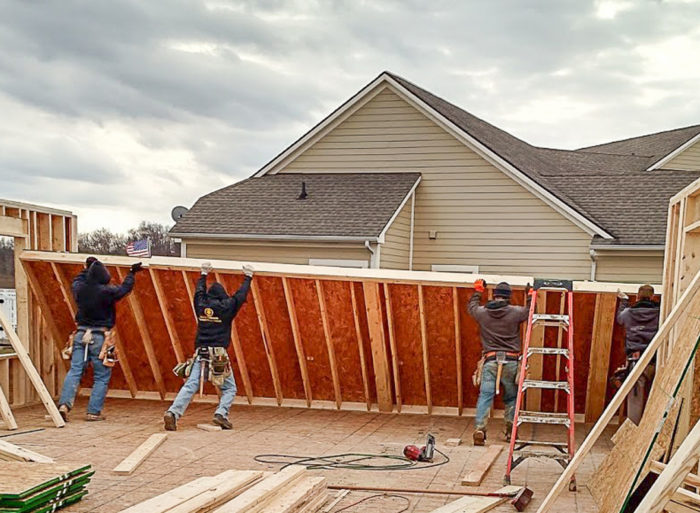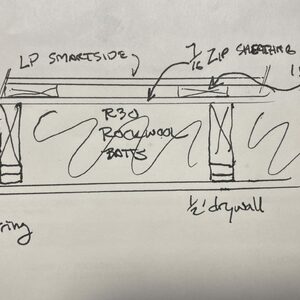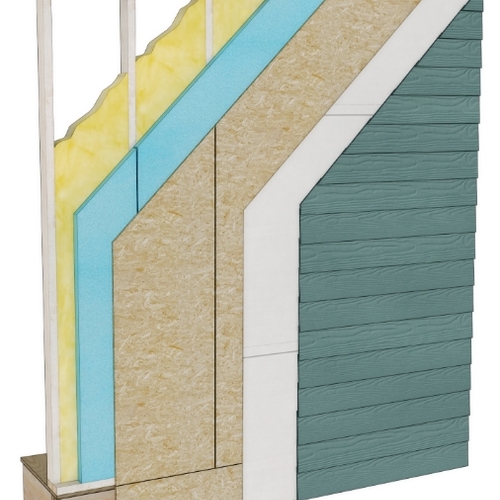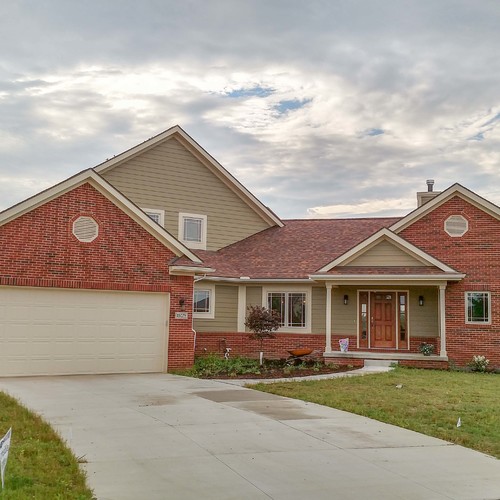Image Credit: All images: Reid Baldwin
Image Credit: All images: Reid Baldwin A stepped concrete foundation provides a ledge for the brick cladding and room for 2 inches of rigid foam insulation. The rim joist area is sealed with spray foam insulation. Spray foam at the top of the wall provides an air-sealing bridge between the interior drywall on the ceiling and the OSB sheathing. Siding is installed over a vented rainscreen. A 2-inch layer of rigid foam insulation isolates a 2x4 framed wall from the concrete foundation. The floor also is insulated with rigid foam, while a vapor barrier prevents the migration of moisture from the ground into the slab.
Editor’s note: This is the one of a series of guest blogs by Reid Baldwin about the construction of his house in Linden, Michigan. The first blog in the series was titled Energy Efficiency and Garage Space for an Airplane.
When I first set out to design our house, I didn’t think very much about construction technology beyond trying to assure myself that what I designed was feasible to construct without extreme costs. (Some of my early designs would have failed that test.)
I set out to learn enough about house construction to assure myself that I wasn’t specifying something stupid. I discovered the very interesting field of building science. At websites like Green Building Advisor and Building Science Corporation, I found smart people debating how to go beyond stupidity avoidance to make houses more comfortable, more durable, and more energy-efficient. (Stupidity avoidance continues to be an important aspect of building science.)
Although builders in my region have adopted standard methods that are used on the vast majority of houses, there are alternatives. Should I be using them? After considerable research, I decided to depart from standard practice for my region in a couple ways. One such departure is adding a layer of exterior rigid foam.
What the walls do
The primary functions of the exterior walls are separating the interior from the exterior and holding up the roof and higher floors. Ensuring that the walls will continue to perform these functions well for many years requires a structure that avoids rot, by keeping any wood parts from being warm and wet simultaneously.
A second function of the exterior walls is to limit heating and cooling loads. This function requires avoiding the flow of air between inside and outside and resisting heat conduction. The traditional approach to resisting heat conduction is to fill the areas between the studs with insulation. Once this is done, however, the studs themselves become a thermal bridge and provide a path for heat to flow through the wall.
A traditional residential wall in Southeast Michigan has wood studs that carry the vertical loads, OSB sheathing to provide rigidity, housewrap to keep out bulk water, and some form of cladding like siding or brick veneer. There is typically cellulose or fiberglass insulation between the studs and drywall on the interior. Some air from inside the house typically gets past the drywall into the wall cavity. In winter, water vapor in that air is adsorbed by the OSB sheathing, which is cold. Hopefully, wetness in the sheathing dries out by vapor diffusion in spring before the wall gets warm enough for rot to form.
To reduce heat conduction, 2×4 studs have given way to 2×6 studs, increasing the effective R-value of the wall from about 9 to about 14. Although the nominal R-value of the insulation is greater than that, the effective R-value of the wall is reduced by thermal bridging through the studs.
What alternatives do we have?
A number of alternative wall structures are in use. One approach to reducing the thermal bridging of the studs is to increase the on-center stud spacing from 16 inches to 24 inches. Another approach is a double-stud wall, which has an inner set of studs and an outer set of studs separated by a few inches. Usually only one set of studs supports the weight of the roof and upper floors.
Taping the seams between OSB panels reduces air leakage through the wall. Some builders use a layer of spray foam between studs to reduce air leakage. Structural insulated panels (SIPs) rely on OSB layers bonded to each side of a rigid foam layer to support the structure, eliminating most of the studs (except where SIPs are joined to one another). Insulating concrete forms (ICFs) use continuous rigid foam layers on the outside and inside to provide R-value and use steel-reinforced concrete in the middle to provide the structure and provide the air barrier. By eliminating wood, ICFs avoid wood rot. Each of these alternatives has advantages and disadvantages.
After studying alternatives, I decided on a 2×6 wall structure that included 2 inches of continuous rigid foam insulation attached to the outside of the OSB sheathing. I selecting Platinum Insulfoam EPS, which provides R-5 per inch. Since this is not reduced by thermal bridging, the effective R-value of the wall increased from about 14 to about 24.
The framing is on 16-inch centers. I discussed 24-inch on-center spacing with the builder, but he had concerns about installing the siding. After some calculations, I decided the effect on overall energy consumption was not enough to make that a battle worth fighting. The layer of continuous exterior insulation makes the heating and cooling loads much less sensitive to framing fraction. That observation made it less painful to see the framers use extra studs in a few places that didn’t seem necessary to me.
One drawback of rigid foam is that it dramatically limits drying to the outside in spring. Therefore, it is important to use a thick enough layer of rigid foam to keep the sheathing warmer than the dew point during the winter so the sheathing does not adsorb water. In Climate Zone 5, where this house is located, R-7.5 in rigid foam is enough to accomplish that.
Insulating the rim joist and building in a rainscreen gap
One of the most problematic air leakage areas is the rim joist. To address this, peel-and-stick flashing is added on the outside and spray foam is applied to the interior of the rim joist. Spray foam also is used at the top of the walls to join the OSB sheathing, which is the air barrier for the walls, to the drywall which forms the air barrier for the ceiling.
On the outside of the rigid foam, 3/4-inch furring strips create an air gap called a rainscreen. The air gap allows the cladding to dry from both sides and prevents vapor that may be driven out of the cladding by sunshine from going into the wall structure. Screws through the furring strips into the studs secure the rigid foam to the wall. Some areas of the house will have brick veneer cladding, while other areas will have James Hardie fiber-cement siding.
In the basement, 2 inches of foam separate the poured concrete foundation wall from a framed wall, keeping all of the wood above the dew point. I looked into alternatives to poured concrete basement walls, such as Superior Walls. The Superior Wall system uses wall sections pre-manufactured in a factory and assembled on site. The wall sections include insulation, which would have allowed elimination of the interior framed wall. Although there are some advantages to the Superior Walls system, I concluded that those advantages were not sufficient to depart from the system my builder is familiar with.
Weekly Newsletter
Get building science and energy efficiency advice, plus special offers, in your inbox.
















10 Comments
What's new
My intention on this house is not to break any new ground technologically relative to what building scientist know about how to build a good house. I did break new ground relative to what is common practice in my region and familiar to the construction contractor base. After building my house, there is at least one custom builder and one framing crew in the area that should be comfortable with building this type of wall assembly. I am hopeful that will have impact beyond one house.
Response to Russell Miller
Russell,
If I lived in rural Africa, I'm sure that I would think that it's laughable than Americans think that a house can have a two-car garage for a gasoline-powered car or two and call the house green. Everything is relative.
Almost every single American is using much more than our share of the world's resources and energy. We need to look in the mirror, not point fingers at people who are, like us, also clustered near the top of the ladder.
-- Martin Holladay
My truck
Reid probably uses a lot less fuel in his plane than my truck chugging miles down the road to Costco in an insatiable quest for cheap disposable consumer goods.
I'd post a pic of the huge jar of olives we bought but I'm too lazy.
REDO
I have chosen to remove my comment.
It is never my intention to degrade anyone for their building choices.
I apologize for my knee jerk reaction!
John Clark,
I haven't been on
John Clark,
I haven't been on a bicycle in 20 plus years.
Martin Holladay,
I have issued an apology above, it is NEVER my intention to point fingers at anyone!
Malcolm Taylor,
Yes at a whole 8mpg my work truck uses plenty of fuel.
Reid,
I hope your home works at well for you. I apologize if I have upset you in anyway. It was a knee jerk respone, not a dig at you or your choices in home construction.
@Russell
(removed)
Malcolm,
You're correct,
Malcolm,
You're correct, before the slow down ten years ago. We found it very hard to compete with other builders. Our spec houses being brick, 2x6 walls, well insulated, etc vs a vinyl sided cracker jack box. Sometimes we were passed up for the cheaper houses. As a younger man I was quick to tell people just what they were getting, and how they would pay in the long run. This isn't a good way to go through life and I understand "telling people what you think at first glance" isn't always the best first reaction or impression".
I learned this lesson early in life and I guess I forgot it at first reading of the article.
In business and in life it always is better to look at things from the other side, of that I'm reminded today.
Thanks
Green impact of my airplane
I am not offended by having my choices challenged. I would like to respond even though Russell has removed his comment. Debates like this have value.
Designing my house to accommodate my airplane added some embodied energy. It took more materials than a comparable house without a hangar. I suspect it added less embodied energy than building a stand alone hangar at the local airport.
Having the airplane at the house has little effect on ongoing energy use. The airplane is kept in unconditioned space, so it doesn't increase my heating or cooling loads. If anything I use less energy because I no longer use any car fuel going to the airport to fly it or to maintain it.
Perhaps I could reduce my carbon footprint by choosing a different hobby. That would depend on what the alternative hobby is. My airplane uses about 8 gallons of fuel per hour. I fly it about 50 hours per year. That is less fuel than I use commuting to work in my C-max hybrid. Golf might use less fuel, unless I took a couple airline trips per year to play during winter like some of my Golfer friends do. Maybe I could take up antique collecting, although then I would need a way bigger house to keep the antiques in.
Russell,
It does bring up a point that occurs quite often in my design practice. The last house I built was a fair bit below "Pretty Good" in terms of energy efficiency. It is situated in a rural area requiring an hours round trip for any shopping or to access any other services. The owners drive two large SUVs. All their recreation requires some sort of machine - boats, quads etc. So between building the house in the first place, and the occupant's lifestyle choices, any upgrade in the levels of energy efficiency in the construction would be insignificant.
From the perspective of someone wanting to mitigate energy use, the project itself is faulty. Another way of looking at it is that if it was being built anyway it should be built as efficiently as possible, even if the gains were dwarfed by the other factors. I don't know what the sweet spot it. To some extent it seems to depend on your values, rather than a straight-forward scientific analysis. None of this is easy. We all just muddle on I guess.
Am envious...
My home when I was a kid abutted a small general aviation airport. Our next door neighbor had an airplane with taxi-strip right to the paved airport runway. I would hang out in the little airport office sometimes; our family knew the airport owner, he was quite an amazing guy. http://www.westsidenewsny.com/news/2013-02-03/decades-of-grit-and-grace-show-their-impact-around-brockport/
The field directly behind our home was used for parachute training. More than once an errant parachutist ended up in our yard. I remember watching one float down on top of my dad while he worked in the vegetable garden. Another time one hit the edge of our roof, ripped the gutter off and damaged my mother's prized rhododendron. The parachutist broke his leg, which was fortunate, as otherwise my mom would have killed him.
And yet somehow, with that much airport and airplane proximity, I never learned to fly. I kick myself about that every now and then. (Yes I know it's never too late.)
Good for you Reid for following your passion, and for posting on GBA.
Log in or create an account to post a comment.
Sign up Log in